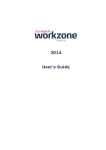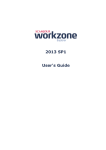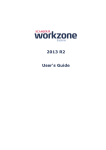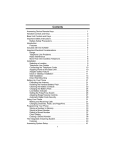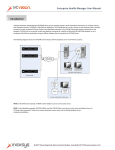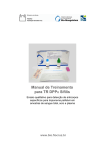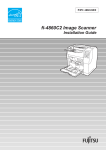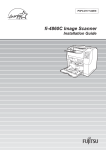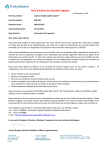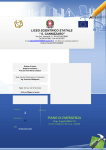Download WorkZone Explorer - User's Guide
Transcript
2014 R2
User's Guide
WorkZone Explorer 2014 R2
Contents
1. User's Guide for WorkZone Explorer 2014 R2
3
2. What's new
5
3. Getting started
8
4. About the folders
10
5. Working with cases
13
6. Working with documents
15
6.1 About documents
7. Search for cases and documents
7.1 Supported search tags
20
27
8. FAQs
30
9. Information for administrators
32
9.1 Optimizing performance and user experience
32
9.2 Advanced features
34
9.3 Troubleshooting
34
10. Terms and conditions
2
16
36
User's Guide
1. User's Guide for WorkZone Explorer 2014 R2
FAQ
W HY U NCL E AR E RROR ME SSAGE S ?
Sometimes File Explorer does not show user friendly and descriptive error messages from the
WebDAV server. When you perform an illegal operation, for example, try to move an archived
document to another case, you only see a general error message such as: Cannot read from
source or disk. Some of the Windows error messages that you might run into are explained in the
FAQ items below.
W HY DO I GE T AN E RROR ME SSAGE W HE N I T RY T O ADD A DOCU ME NT T O T HE D RAF TS FOL DE R ?
You can only create new documents in folders that represent specific cases. You cannot create a
new document directly in the Drafts folder, because the WorkZone system requires a case for
placing the document correctly. If you to try add a document to the Drafts folder, you get the
following Windows messages depending on where you try to add it from:
A device attached to the system is not functioning.
- or Can't read from the source file or disk.
W HY DO I GE T AN E RROR ME SSAGE W HE N I T RY T O CRE AT E A NE W CASE FOL DE R ?
Some folders do not allow case creation. You can create new cases in the Open cases,
Unclassified cases folders, and in specific case folders. If you try to create a new case folder in
a folder, which does not allow case creation, you get the following Windows error message:
Unable to create the folder 'New folder' - File system error
See also Create case.
View all FAQS
ADVANCED FEATURES
Optimize performance
3
WorkZone Explorer 2014 R2
RELATED PRODUCT DOCUMENTATION
WorkZone Content Server Installation Guide
WorkZone Services blog
SCANJOUR LINKS
ScanJour website
ScanJour support
ScanJour on
4
User's Guide
2. What's new
WORKZONE EXPLORER 2014 R2
Flat case folder hierarchy
You can now change the setup of WorkZone Explorer to display child cases in lists as in WorkZone
Client and Captia Web Client. Parent and child cases now display in a flat hierarchy in the lists. By
default WorkZone Explorer does not display child case folders in lists in File Explorer.
For information on changing the setup, see Configuring WorkZone Explorer in the WorkZone
Content Server Installation Guide.
Shortcut to immediate parent case in search results
When you free text search on cases using the WorkZone Cases search connection and you
double-click on a case in the search results, you can see if it is a child case if the folder contains
the shortcut
. Next to the shortcut, the name of the immediate parent case is shown. Doubleclick the shortcut to open the immediate parent case in File Explorer.
See Search for cases and documents.
Danish search tags
You can now filter search results using Danish search tags in a Danish version of Microsoft
Windows. See Filter search results using search tags.
W ORK Z ONE E XPL ORE R 2014
New folders
The following folders are new:
Changed cases
Changed documents
Shared lists
Unanswered documents
Unclassified cases
See Folder types.
Child cases inherit the case class and access code of the parent case
When you create a new folder in a case folder, the new folder becomes a child case and the child
case inherits the case class and access code of the parent case. See Create child cases.
5
WorkZone Explorer 2014 R2
PDF sub folder in case folders
A new PDF sub folder in case folders contains PDF versions of documents on the case. See PDF
versions of documents.
Letter date displays as date modified in File Explorer
The letter date entered in WorkZone Client or Captia Web Client is now shown in the Date
Modified column in File Explorer.
Shortcut to next child case folder appears when the path in File Explorer is very
long
If your case folder hierarchy is deep, the path in File Explorer becomes very long and at some
point the maximum limit set by Microsoft Windows is met, meaning that you cannot browse to
the next child case folder using the arrow buttons in File Explorer. In this case, a shortcut to the
next child case folder in the hierarchy appears. Double-click the shortcut to open the next child
case folder and then you can continue using the arrow keys to browse further through the folder
hierarchy.
Shorter case folder names
The consecutive case number has been removed from the case folder names to shorten the
name. Example of a case folder is: (2014-000005) Test case.
W ORK Z ONE E XPL ORE R 2013 R2
WorkZone Explorer 2013 R2 contains the following new features:
l
WorkZone Explorer now displays the following new folders in File Explorer:
o
Recent cases
o
Recent documents
o
Favorite cases
o
Favorite documents
o
Followed cases
o
Followed documents
o
Reading list cases
o
Reading list documents
See Folder types for more information about the new types of folders.
l
Cases folders representing closed cases now have an X on the icon
archived document icon
6
has been removed from the icon.
. The X on the
User's Guide
l
The modified date for a case is now updated automatically when documents on the case
are edited, or when documents are added or removed from the case. See Date Modified on
Cases.
W ORK Z ONE E XPL ORE R 2013 SP1
l
The versioning part, DeltaV, of the WebDAV protocol is now supported by WorkZone
Explorer.
l
New folder named My lists, which exposes searches defined and saved by the user from
WorkZone Client or Captia Web Client. See Folder types.
l
New icon for read-only documents. Read-only documents used to be highlighted in blue.
Now the
icon indicates that the document is read-only. See Read-only documents.
l
Create new cases. See Working with cases.
l
Create child cases. See Working with cases.
l
Free text search on cases and documents. See Search for cases and documents.
7
WorkZone Explorer 2014 R2
3. Getting started
WorkZone Explorer uses WebDAV (Web Document Authoring and Versioning), which is a
standard document protocol over HTTP. With WorkZone Explorer, you can manage cases and
documents from File Explorer. You can perform common operations on cases and documents
such as creating and renaming cases and documents, opening, editing, and saving documents
directly into the WorkZone archive from a document editor that supports the WebDAV protocol,
for example, Microsoft Office or Notepad.
WorkZone Explorer is part of the WorkZone Content Server installation. Note that it is not
required to install a client, such as WorkZone Client or Captia Web Client.
START WORKZONE EXPLORER
1. Enter this URL in your browser: http://<host>/explorer.
Example: http://db01/explorer.
A welcome page displays:
8
User's Guide
2. Click Browse using Windows Explorer to open File Explorer:
In File Explorer, you can also access the database directly by typing \\<host>\explorer in the
address bar.
WorkZone Explorer now displays folders in File Explorerthat represent the standard case and
document lists, see About the folders .
Tip: You can map a point in the folder structure to a network drive in File Explorer. Right-click on
Network, click Map network drive and then browse to select the folder that you want to map.
MULTIPLE DATABASES
If more than one WorkZone Content Server database was specified during installation of the
WorkZone web server, you open them in separate File Explorer windows.
LEARN HOW TO WORK WITH CASES AND DOCUMENTS IN FILE EXPLORER
To learn more about the type of folders shown in File Explorer, see About the folder structure.
To learn more about working with cases and documents, see Working with cases and Working with
documents.
Important: You can optimize the performance of WorkZone Explorer by changing a couple of
Internet Explorer settings, see Optimize performance and user experience.
9
WorkZone Explorer 2014 R2
4. About the folders
WorkZone Explorer gives you access to folders in File Explorer that represent standard case
and document lists, for example, Drafts, Open Cases, and so on. In addition, there are search
connectors and a Recycle Bin folder.
FOLDER TYPES
The table below gives you an overview of the types of folders that you see in File Explorer:
Folder type
Case lists
Description
Folders that represent standard case lists, such as:
Open cases
Cases currently placed with me
Cases with no case handler and unit
My case reminders one week ahead
Unit's cases with no case handler
Unit's open cases
Document lists
10
Folders that represent standard document lists, such as:
User's Guide
Folder type
Description
Documents
Drafts
Document reminders
Documents with no case handler and unit
Scanned today
Today
Case folders
Folders that represent specific cases in the database. A folder
represents one case and contains all the documents of that
case. It may also contain child cases. Child cases are shown as
sub folders.
The case number is displayed in brackets in the folder name,
for example, {2014_000005} Test case.
If the case folder has the icon
, the case is closed.
Each case folder contains a shortcut to open this case. Doubleclick the
shortcut to open the case in WorkZone Client or
Captia Web Client.
My lists
This folder contains searches that you have saved from
WorkZone Client or Captia Web Client to the database. Sub
folders in the My lists folder correspond to saved searches.
Shared lists
This folder contains lists that other users or your organization
have shared with you.
Note: You can share lists from WorkZone Client only.
Recent cases
The folders contain the last cases and documents you have
opened, so that you can quickly open a case or document
again.
Recent documents
Favorite cases
Favorite documents
Followed cases
Followed documents
The folders contain the cases and documents that you have
marked as favorites in WorkZone Client or dragged and
dropped to the favorite folders in File Explorer. See Add or
remove cases to the Favorite cases folder and Add or remove
documents in the Favorite documents folder.
The folders contain cases and documents that you have marked
as followed and that you want to be able to find quickly. For
example, you might want to follow another case handler's
cases and documents. Drag and drop the cases and documents
that you want to follow to either the Followed cases or
11
WorkZone Explorer 2014 R2
Folder type
Description
Followed documents folders.
Changed cases
Changed documents
Reading list cases
Reading list documents
The folders contain cases and documents that have been
changed by other users since you viewed them last time. The
blue color indicates that a case or document has changed.
The folders contain lists of cases and documents that you want
to remember to read. You add cases and documents by
dragging and dropping them in the reading list folders.
In some cases, cases and documents are also added to the
reading lists automatically. For example, if a document has
been changed by someone else or if you are added as a case
handler on a case, this case or document is marked in blue.
Once you have opened the cases or documents, they are
automatically removed from the reading list folders. You do not
have to open the cases or documents from the reading lists,
you can also open them from any other folders.
Unclassified cases
This folder contains the cases with you as a case handler that
have not been classified yet. An unclassified case is a case in
the case group named SJ-TEMP. SJ-TEMP is the default case
group used when creating cases from WorkZone Explorer. For
more information, see Create case.
Unanswered documents
This folder contains documents with reply deadlines that you
have not yet replied to.
Recycle Bin
The Recycle Bin contains documents that you have moved
from other folders to this folder in order to delete them. The
Recycle Bin folder contains a folder named Restore that
enables you to restore a deleted document from the Recycle
Bin folder to the case it was originally saved on. For more
information, see Delete and restore documents.
Important: Due to performance reasons WorkZone Explorer displays the 1000 most recent
entries in a folder. For documents, it is related to the last document update and not the last
change of the document meta data. For cases, it is related to the last meta data change on that
case.
12
User's Guide
5. Working with cases
You can perform the following actions on cases in File Explorer.
CREATE CASE
You can create new cases in File Explorer by creating new subfolders in these folders:
l
Open cases
l
Unclassified cases
l
Case folders
When you create a new case through WorkZone Explorer, it is created automatically in a
temporary case group named SJ-TEMP. You can change the case group and other required
information later using WorkZone Client or Captia Web Client. Cases that are created in SJ-TEMP
are automatically added to the Unclassified cases folder regardless of where they were created.
Note: If your organization only use facets and not case classes, you can configure WorkZone
Explorer to add a specific case class as the default case class. This is done in the web.config file.
For more information, see Configure file class for WorkZone Explorer in the WorkZone Content
Server Installation Guide.
Important: The create case functionality is not available by default. Case creation must be
enabled on the SJ-TEMP case class in WorkZone Configuration Management.
CREATE CHILD CASES
You can create child cases in File Explorer in two ways:
l
Move a case folder to another case folder. The case folder that you move becomes a child
case.
l
Create a new folder in a case folder. The new folder becomes a child case. The child case
inherits the file class and access code of the parent case.
RENAME CASES
You can rename a case by renaming the case folder.
ADD OR REMOVE CASES TO THE FAVORITE CASES FOLDER
You add cases to the Favorite cases folder by dragging and dropping case folders in to the
Favorite cases folder.
To remove a case from the Favorite cases folder, drag and drop the case folder in to the
Recycle bin folder.
Note: The case is not deleted. It is only removed from the Favorite cases folder.
13
WorkZone Explorer 2014 R2
DATE MODIFIED ON CASES
The date modified for a case is updated automatically in File Explorer when documents on the
case are changed or when documents are added to or removed from the case.
Note: Sometimes it may look as if a user has updated a case without having the proper access
rights. This happens when the user has access to a document on the case but not to the case
itself. For example, when a user edits a document that is not protected by the case and the user
does not have update access to the case. This is standard behavior and does not represent a
security issue.
14
User's Guide
6. Working with documents
You can perform the following actions on documents in File Explorer using WorkZone Explorer.
6.1 About documents
16
CREATE NEW DOCUMENTS
You can create new documents directly in File Explorer or by selecting Save As from a document
editor.
You can only create new documents in case folders. You cannot create a new document directly in,
for example, the Drafts folder, because the WorkZone system requires a case for placing the
document correctly in the system.
You can also create a new document by copying it from another location to a case folder. In this
case, the read-only state of the document is kept in WorkZone Explorer. It will be created with the
state UÅ (Draft) or UL (Locked) depending on the read-only file property of the new document.
The document will be created with few metadata, the title is taken from the file name, the state
from the read-only attribute, and the document type used is N (Internal).
The system automatically appends the Document identifier identifier when refreshing File
Explorer. You can open the document using either the file name supplied by the client (without the
Dxxxxx identifier), as long as the document remains on the same case and is not further renamed,
or you can use the full name (with the Dxxxx identifier).
RENAME DOCUMENTS
You can rename documents from File Explorer. The new name replaces the document title in the
WorkZone system. The (Dxxxxx) identifier is automatically appended when refreshing File
Explorer. The (Dxxxxx) identifier does not become part of the document title in the WorkZone
system and you do not have to keep the (Dxxxx) identifier in the new name, it will automatically
be appended upon refresh of File Explorer. You can open the document with and without the
(Dxxxxx) identifier in the file name.
WORK WITH DOCUMENTS OFFLINE
If you have taken a document offline, for example, copied it to the Windows Desktop or to a USB
stick, you can copy it back into the WorkZone database. This means that the document is updated
in the database provided that you have not changed the (Dxxxx) part of the file name. When you
copy the document back, File Explorer displays a message asking if you want to replace the
existing version, keep both versions, or cancel. If you copy to a case folder, you can choose
between all three options. However, if you copy the document to a folder that represents a
standard list, for example, the Drafts folder, you can only choose between replace and cancel.
Note: If you save the document with a new name when working offline and then try to copy it back
to the WorkZone database, a message displays asking you whether you want to replace the
existing document or keep both versions. If you reply Replace, the document is copied back to the
database but it keeps the original name. If you want to use a new name, you must rename the
document in File Explorer.
15
WorkZone Explorer 2014 R2
MOVE DOCUMENTS
You can move documents from one case to another provided that the state of the document in
the WorkZone system allows it. You can move documents using drag and drop or cut and paste.
COPY DOCUMENTS
You can copy documents from one case to another case or even from one database another
database. When you copy a document, a copy of the document is created but document meta
data have new default values. This means, for example, if you copy a document with access
codes, the copy gets the default access codes and not the access code of the original document.
DELETE AND RESTORE DOCUMENTS
It is not possible to delete documents directly from folders but you can move documents to the
Recycle Bin and then delete the document from this folder. The Recycle Bin is personal,
which means that you only see the documents that you have moved there. The Recycle Bin
contains a Restore folder. If you drag a document from the Recycle Bin to the Restore
folder, it will be moved back to the case folder where it was originally placed. It is also possible
to restore a recycled document to another case by moving it from the Recycle Bin to another
case folder.
ADD OR REMOVE DOCUMENTS IN THE FAVORITE DOCUMENTS FOLDER
You can add documents to the Favorite documents folder by dragging and dropping the
documents on the folder.
To remove a document from the Favorite documents folder, press the Delete button. A
message displays "Are you sure you want to permanently delete this file?". Click Yes to remove
the document from the list.
Note: The document is not deleted but only removed from the Favorite documents folder.
PDF VERSIONS OF DOCUMENTS
All case folders contain a PDF folder for PDF versions of documents created on a case. It
contains the PDF versions that you have created from WorkZone Client or Captia Web Client.
6.1 About documents
You can open and edit all documents from any type of folder provided that you have the
corresponding application installed. Note that the same document may appear in several
folders. For example, a draft document is located in both the Drafts folder and in the case
folder where it belongs. You can open and edit the document from either folder. The changes
you make are reflected in both locations. If you open a document from the Recycle Bin, the
document opens in read-only mode.
The example below shows the documents on a specific case:
16
User's Guide
Note: The WorkZone Explorer server does not expose cases of the state “O” (so-called
"information cases") as they represent metadata without a document, which is not relevant for
WorkZone Explorer.
READ-ONLY DOCUMENTS
Read-only documents are documents that have the states UL (Locked ), ARK (Archived) or AFS
(Closed). Documents with these states cannot be edited. Microsoft Office products recognize the
state and open the documents in read-only mode.
Document state
Possible actions
UL (Locked)
It is a read-only document. You can move and
rename the document.
ARK (Archived) or AFS (Closed)
It is a read-only document. You can rename the
document.
You can change a non-read-only document to read-only in the File Properties dialog box. If you
do so, you change the document state to UL, a locked draft. You cannot remove the read-only
attribute as the system does not allow this. If you try to change the attribute, it will have no effect.
See also Document attributes and document states.
CHECK-OUT
Microsoft Office products automatically lock (documents are checked out in WorkZone products)
editable documents when they are opened. This prevents two users from editing the same
document at the same time, or the same user from editing the same document from different
folders at the same time. For example, Microsoft Office has a feature that notifies the second user
who opens a document when the document becomes available for editing. Microsoft Office can also
allow editing from both users at the same time and automatically merge the changes. This feature
works automatically with WorkZone Explorer. This is the Microsoft Office dialog box shown when a
second (or third) user opens a document that is already being edited by someone else:
17
WorkZone Explorer 2014 R2
Note: Some documentation editors, for example Notepad, only locks (checks out) the
document when saving. This means that the last edit is always applied.
DOCUMENT IDENTIFIER
All documents have a document identifier (Dxxxx) as part of the file name.
DRAFT VERSIONING
If draft versioning is enabled in WorkZone Configuration Management, new versions of a
document are created automatically. Versioning applies to documents with the state UÅ (Draft)
or UP (Personal draft).
DOCUMENT ATTRIBUTES AND DOCUMENT STATES
In the example below, the Attributes column is added to the folder view in File Explorer. In this
column, you can see the different file attribute combinations that can be exposed from the
system.
18
User's Guide
Attribute
Document state and possible actions
A
An editable document with the state UÅ (Draft) or UP (Personal draft). You can
edit, move, rename, and change the document to read-only.
RAO
A read-only document with the state UL (Locked). You can move and rename the
document.
RO
A read-only document with the state ARK (Archived) or AFS (Closed). You can
rename the document.
19
WorkZone Explorer 2014 R2
7. Search for cases and documents
You can search for cases and documents directly from File Explorer. Before you can start doing
searches you must enable searching by adding two search connectors, one for cases and one
for documents.
7.1 Supported search tags
27
ENABLE FREE TEXT SEARCH ON CASES AND DOCUMENTS
Search Cases.osdx search connector or the
1. In File Explorer, double-click the
Search Documents.osdx search connector.
2. In the Add Search Connector dialog box, click Add to add the WorkZone Cases
and WorkZone Documents search connectors to File Explorer. The search
connectors WorkZone Cases in [database] and WorkZone Documents in
20
User's Guide
[database] are added to Favorites.
SEARCH FOR CASES AND DOCUMENTS
1. Double-click the WorkZone Cases or the WorkZone Documents search connector
depending on what you want to search for.
2. Enter a search term the Search field and press ENTER. The search result is listed
below.
Note: The search results displays maximum 1000 hits. The most recent cases and
documents are shown in the search result.
Example of a document search result:
Example of a case search result:
21
WorkZone Explorer 2014 R2
If you double-click on a case in the search results and it is a child case, you can
double-click the
shortcut to open the parent case in File Explorer.
3. Double-click the case or document to open it.
Important: The search in WorkZone Explorer should not be confused with the free text search
in File Explorer, which searches in file names.
FILTER SEARCH RESULTS USING SEARCH TAGS
When you search using search connectors, you can use search tags to filter the search results
for better overview. The search tags filter the current search results based on the text that you
enter. Case folders and documents are displayed as search results if your search text matches
the name, tags, or other properties.
E XAMPL E : D OCU ME NT SE ARCH
You want to search for a document with a specific text in the document title, for example "widearea networks".
In the search box, enter:
title:"wide-area networks"
or
title:(wide-area networks)
Note: If you omit the quotes or the brackets, you search for "wide-area" AND "networks".
22
User's Guide
The search results display two documents on two different cases.
E XAMPL E : C ASE SE ARCH
You want to search for cases in a specific case group. You know that the case group contains the
text "analysis". In WorkZone Explorer, the case group is shown as a folder in a path.
In the search box, enter:
folder:analysis
The search results show one case where the case group contains the word "analysis".
Filter using dates, date ranges, and date and size expressions
You can use dates, date ranges, and date and time expressions with some of the search tags. You
can, for example, filter on when cases and documents were created, modified, due, or closed.
Date
Use these date formats to filter based on a date:
l
dd-MM-yyyy
l
yyyy-MM-dd
l
dd/MM-yyyy
E XAMPL E
You want to view cases that were modified on a specific date. In the search box, enter:
23
WorkZone Explorer 2014 R2
datemodified:15-01-2015
Note: If Windows is set up to use a different date format than dd-MM-yyyy, the search on date
will not work. You can change the Windows date format Control Panel > Clock, Language,
and Region > Change date, time, or number formats > Short date field.
Date range
Use the format dd-MM-yyyy .. dd-MM-yyyy to filter on cases and documents within a certain
period of time.
E XAMPL E
You want to view cases that were modified the first two weeks of January. In the search box,
enter:
datemodified:01-01-2015 .. 15-01-2015
Date expressions
You can use the following date expressions with search tags:
l
today
l
yesterday
l
this week
l
last week
l
this month
l
last month
l
this year
l
last year
E XAMPL E
You can, for example, filter on cases or documents that were modified today. In the search box,
enter:
modified:today
Size expressions
You can use the following size filters with the search tag:
l
empty
l
tiny
l
small
l
medium
l
large
l
huge
l
gigantic
E XAMPL E
You want to view large documents.
size:large
24
User's Guide
Combine search tags
You can combine search tags and this way narrow your search results even more. Separate the
search tags with a space.
E XAMPL E
You want to search for a document with the text "research" in the document title with a specific
case group that contains the text "laws". In the search box, enter:
title:research folder:laws
More search tag examples
Below you can find examples of how to use search tags.
Search tag
You want to view
Enter in Search field
created:
Cases or documents created on a
specific date.
created:15-01-2015
created:today
Cases or documents that were
created today.
datecreated:
Same as above.
datecreated:05-01-2015
date:
Same as above.
date:05-01-2015
modified:
Cases or documents that were
modified this week.
modified:this week
datemodifie
d:
Cases and documents that were
modified yesterday.
datemodified:yesterday
due:
Cases or documents that are due
within a certain period of time.
due:01-01-2015 .. 15-01-2015
completed:
Cases or documents that were closed
within a certain period of time, for
example this month.
complete:this month
folder:
Cases or documents with in a specific
case group, for example a case group
named "laws".
folder:laws
folderpath:
Same as above
folderpath:laws
open:
Only closed cases or documents or
only open cases or documents.
Closed cases or documents:
open:false
Open cases or documents:
open:true
end:
Cases or documents with a specific
planned completed dato (cases) or
reply deadline (documents), for
example today.
end:today
owner:
Cases or documents assigned to a
specific case handler, for example
"Martin".
owner:Martin
25
WorkZone Explorer 2014 R2
Search tag
You want to view
Enter in Search field
author:
Cases or documents created by a
specific employee. You want to
search on the employee 's initials, for
example "mar".
author:mar
Tip: You can also enter: author:@me to
only view cases that were created by
you.
authors:
title:
Cases or documents created by a
specific employee and you want to
search on the full name or part of the
name, for example "Anne-lise
Nielsen".
authors:Anne-Lise Nielsen
Cases or documents with specific
words in the case or document title,
for example "research".
title:research
Note: The search term is case sensitive.
To search on part of a name, add an *
before and after the search term, for
example, authors:*Anne-Lise*.
Note: To search for an exact phrase in a
title, enclose your search terms in
quotes or brackets, for example
title:"research center" or title:(research
center).
The search result includes cases or
documents with the same words in the
same order as inside the quotes or
brackets.
name:
Same as above
name:research
filename:
Cases or documents that contains a
specific text in the file name, for
example "hearing".
filename:hearing
person:
Cases with a specific party assigned,
for example "Anne-lise Nielsen".
person:nielsen
person:anne-lise
Note: This is a combined search on first
and last name.
to:
Cases or documents with a specific
party with the role Recipient.
to:Marcus
Note: This is a free text search on either
Name 1 or Name 2.
26
User's Guide
Search tag
You want to view
Enter in Search field
from:
Cases or documents with a specific
party with the role Sender.
from:filippa
Note: This is a free text search on either
Name 1 or Name 2.
cc:
Cases or documents with a specific
party with the role Copy recipient.
cc:marie
Note: This is a free text search on either
Name 1 or Name 2.
size:
Large documents.
size:large
extension:
Documents of a specific file
extension, for example Microsoft
Excel sheets.
extension:xlsx
See Supported search tags for a list of search tags that includes the name of the fields that are
searched in WorkZone Content Server.
7.1 Supported search tags
The table below lists the search tags that you can use to filter the search results of the WorkZone
Cases in [database] and WorkZone Documents in [database] search connectors. The tables
lists the search tags and the case and document fields in WorkZone Content Server that the search
applies to.
Search tag
Case fields
Document fields
Accepts
created:
created
created
Date
Notes
Date range
Time expressions
datecreated:
created
created
Date
Date range
Time expressions
date:
created
created
Date
Date range
Time expressions
modified:
updated
doc_time
Date
Date range
Time expressions
datemodifie
d:
updated
doc_time
Date
27
WorkZone Explorer 2014 R2
Search tag
Case fields
Document fields
Accepts
Notes
Date range
Time expressions
due:
current_
reminder:reminder_
date
current_
reminder:reminder_
date
Date
Date range
Time expressions
completed:
closed
record_closed
Date
Date range
Time expressions
folder:
file_class or file_
class/path
file_elab
string
For case
search: If
string starts
with = file_
class is
used
otherwise
file_
class/path
is used.
folderpath:
file_class or file_
class/path
file_elab
string
For case
search: If
string starts
with = file_
class is
used
otherwise
file_
class/path
is used.
open:
closed
locked (meaning UL,
ARK or AFS)
Bool (true / false)
end:
plan_completed
reply_time_limit_
date
Date
Date range
Time frames
owner:
officer
officer
string
author:
create_user
create_user
string
authors:
create_user/note
create_user/note
string
title:
title
title
string
name:
elab
title
string
filename:
title
title
string
28
User's Guide
Search tag
Case fields
Document fields
Accepts
Notes
person:
party/name/registe
r_text:register_txt
party/name/registe
r_text:register_txt
string
Free text.
to:
party/name/registe
r_text:register_txt
party/name/registe
r_text:register_txAt
string
Free text.
Only parties
with
role/custo
m_label =
Modtager is
searched.
from:
party/name/registe
r_text:register_txt
party/name/registe
r_text:register_txt
string
Free text.
Only parties
with
role/custo
m_label =
Afsender is
searched.
cc:
party/name/registe
r_text:register_txt
party/name/registe
r_text:register_txt
string
Free text.
Only parties
with
role/custo
m_label =
Kopimodt is
searched.
size:
NA
doc_length
size filters
extension:
NA
record_
ext:extension
string
[default]
register_
text:register_txt
register_
text:register_txt
string
Free text
search
29
WorkZone Explorer 2014 R2
8. FAQs
This section contains a list of frequently asked questions on WorkZone Explorer functionality.
Click any question below to see the answer.
W HY U NCL E AR E RROR ME SSAGE S ?
Sometimes File Explorer does not show user friendly and descriptive error messages from the
WebDAV server. When you perform an illegal operation, for example, try to move an archived
document to another case, you only see a general error message such as: Cannot read from
source or disk. Some of the Windows error messages that you might run into are explained in
the FAQ items below.
W HY DO I GE T AN E RROR ME SSAGE W HE N I T RY T O ADD A DOCU ME NT T O T HE D RAF TS FOL DE R ?
You can only create new documents in specific case folders. You cannot, for example, create a
new document directly in the Drafts folder, because the WorkZone requires a case for placing
the document correctly in the system. If you to try add a document to the Drafts folder, you
get the following Windows messages depending on where you try to add it from:
A device attached to the system is not functioning.
- or Can't read from the source file or disk.
W HY DO I GE T AN E RROR ME SSAGE W HE N I T RY T O CRE AT E A NE W CASE FOL DE R ?
By default WorkZone Explorer is not configured to allow creation of new cases. Case creation
must be enabled on the SJ-TEMP class in the file class system. You apply this configuration
using WorkZone Configuration Management. If you try to create a new case, you get the
following Windows message:
Unable to create the folder 'New folder' - File system error
W HY DO I GE T AN E RROR ME SSAGE W HE N I T RY T O CRE AT E A NE W CASE FOL DE R ?
Some folders do not allow case creation. You can create new cases in the Open cases,
Unclassified cases folders, and in specific case folders. If you try to create a new case folder
in a folder, which does not allow case creation, you get the following Windows error message:
Unable to create the folder 'New folder' - File system error
See also Create case.
W HY DO I GE T AN E RROR ME SSAGE W HE N I T RY T O MOVE A DOCU ME NT FROM ONE FOL DE R T O
ANOT HE R ?
You are probably trying to:
l
Move a document from one standard list to another.
l
Move a document from a case folder to a standard list, for example to the Open cases
folder.
30
l
Move a document to a closed case.
l
Move a document that is archived or closed.
User's Guide
This is not possible. In these cases, you get the following Windows error message:
Can't read from the source file or disc.
W HY ARE FOL DE RS NOT DE L E T E D W HE N T HE Y SE E M T O BE ?
It is not possible to delete folders using WorkZone Explorer although it may look so in File
Explorer. If you try to delete an empty folder, it looks as if the folder was successfully deleted but
if you press F5 to refresh, the folder reappears. If you try to delete a folder with content, nothing
happens after you have confirmed the deletion. File Explorer does not display any error message
in this case.
W HY DO I GE T A U NCL E AR E RROR ME SSAGE W HE N I T RY T O RE NAME A DOCU ME NT ?
There are several renaming scenarios where you might get this Windows error message:
Can't read from the source file or disk
For example, if you try to:
l
Change the document ID (DXXX) in the document name. It is not possible to change the
ID, only the document name can be changed.
l
Rename a document, which is saved on a closed case. This is not possible.
l
Rename a document in File Explorer but the document is opened in WorkZone Client or
Captia Web Client.
W HY ARE DOCU ME NT S NOT SHOW N IN F IL E E XPL ORE R AFT E R MOVING ?
When you move documents between folders in File Explorer, File Explorer sometimes cannot handle
the WorkZone mechanism that allows the same document to be exposed in multiple folders. When
you move a document to the Restore folder, the document is actually moved somewhere else. It
seems that File Explorer caches the information on the document location and refuses to open the
document from somewhere else even if it is shown in the new location after refreshing. Try again a
bit later and this issue is resolved.
31
WorkZone Explorer 2014 R2
9. Information for administrators
The topics below are targeted at administrators of WorkZone Explorer.
9.1 Optimizing performance and user experience
32
9.2 Advanced features
34
9.3 Troubleshooting
34
9.1 Optimizing performance and user experience
To ensure optimal performance and user experience of WorkZone Explorer, you can apply
specific configurations to clients and/or to the network/domain issued by group policies.
LAN AUTOMATICALLY DETECT SETTINGS
If browsing the WorkZone Explorer folders is slow, make sure that the Automatically detect
settings check box in the Local Area Network (LAN) Settings dialog box is not selected on
the client. To open this dialog box, in Internet Explorer click Tools > Internet options >
Connections tab > LAN Settings.
INTERNET SECURITY ZONES
The WebDAV protocol is based on http and therefore the Internet Security zones applies to
WorkZone Explorer. To ensure the best user experience and optimal performance, the
WorkZone Explorer host name must be configured correctly in the Internet Security Zones.
32
User's Guide
1. In Internet Explorer, click Tools > Internet options > Security tab.
2. Add http(s)://webdavhost to either the Trusted sites zone or the Local intranet
zone.
The Local intranet zone must be selected to have automatic integrated user
authentication performed by Windows without Log on dialog boxes.
3. Add file://webdavhost to the Trusted sites zone.
If the file protocol is added to the Local intranet zone, searching using the search
connectors perform slowly when showing the results. In some cases, you might
receive a security warning when opening a document folder location from a search
result or when moving documents from the Recycle Bin to the Restore folder. If you
want to avoid these security prompts make sure that Launching applications and
unsafe files is allowed for the Trusted Sites zone.
33
WorkZone Explorer 2014 R2
9.2 Advanced features
PERMANENT LINKS
It is possible to make permanent links to any document or case in the archive. This is available
through a hidden folder called ".archive". All you need to know is the DNS, the ID, and the file
extension, and then you can open any document using this http address:
http://[WebDAVHostHeader]/[DSN]/.archive/WhateverYouWant (D[RecordKey]).
[Extension].
This mechanism can also be used to generate permanent links to documents.
You can also show cases through the .archive folder using:
http://[WebDAVHostHeader]/[DSN]/.archive/WhatEverYouWant (C[FileKey])
VIEW ERROR MESSAGES
Sometimes File Explorer does not show user friendly and descriptive error messages from the
WebDAV server in case of errors or illegal operations. See FAQ.
If you want to see the real error from the system, you can use Fiddler on the client and this way
see the actual response and error from the server.
RUN WORKZONE EXPLORER ON A WINDOWS SERVER
It is not possible to access clients or services directly from the web server. For information on
how to enable access from the web server, see Microsoft article 896861.
If you want to run WorkZone Explorer from File Explorer on a Windows Server operating
system, you must also enable the Windows feature called Desktop Experience.
9.3 Troubleshooting
Click an issue below to see the solution or workaround.
A U T OMAT IC A U T HE NT ICAT ION OF U SE RS FAIL S W HE N ACCE SSING W ORK Z ONE E XPL ORE R T HROU GH
AN
F QDN HOST
If you access WorkZone Explorer through an FQDN host name, automatic Windows
authentication of users will not work. An error message is shown or the Windows Logon window
displays repeatedly.
To make the logon happen automatically, add the http(s) address to the WorkZone Explorer
host to the Windows registry named AuthForwardServerList. For example:
http://db01.lmdom.local.
You can find information on how to make this change in the registry in the Microsoft article
943280. Follow the instructions listed under Registry information in the Resolution section.
Notes:
34
User's Guide
l
You do not need to install the hotfix mentioned in the Microsoft article.
l
The hotfix mentioned in the Microsoft article is included in Windows 8 although Windows 8
is not listed in the Properties section.
35
WorkZone Explorer 2014 R2
10. Terms and conditions
INTELLECTUAL PROPERTY RIGHTS
This document is the property of ScanJour. The data contained herein, in whole or in part, may
not be duplicated, used or disclosed outside the recipient for any purpose other than to conduct
business and technical evaluation. This restriction does not limit the recipient’s right to use
information contained in the data if it is obtained from another source without restriction.
DISCLAIMER
This document is intended for informational purposes only. Any information herein is believed to
be reliable. However, ScanJour assumes no responsibility for the accuracy of the information.
ScanJour reserves the right to change the document and the products described without notice.
ScanJour and the authors disclaim any and all liabilities.
ScanJour is a trademark used under license by ScanJour A/S. All other logos, trademarks and
service marks are the property of the respective third parties.
Copyright © ScanJour A/S 2015. All rights reserved.
36




































